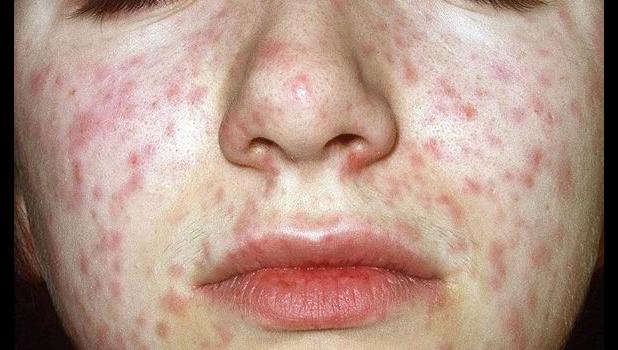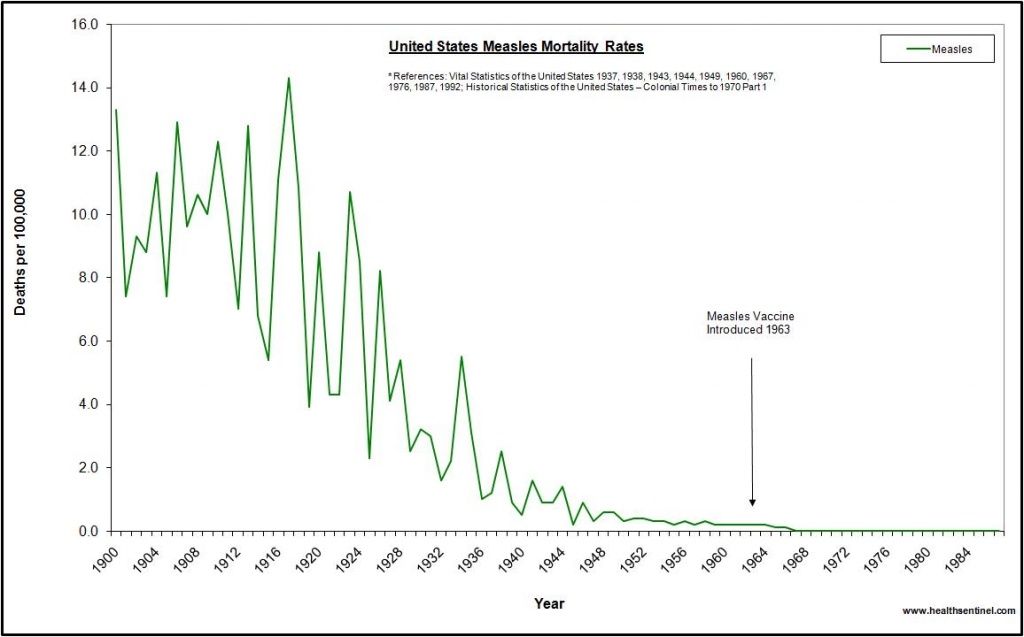
By Dr. Viera Scheibner (PhD)
Measles vaccination in the US and many other countries started in the early 1960s, at the time when measles was naturally abating and was heading for the 18 year low. That’s why the vaccine seemingly lowered the incidence; however, this was only coincidental with the natural dynamics of measles.
As one of many examples involving all infectious diseases of childhood against which vaccines have been developed, ever since any measles vaccines have been introduced and used in mass proportions, reports of outbreaks and epidemics of measles in even 100% vaccinated populations started filling pages in medical journals.
Reports of serious reactions including deaths also appeared with increasing frequency. They are the subject of a separate essay.
Atypical measles – a new phenomenon only in the vaccinated
It is less well known to the general public that vaccinated children started developing an especially vicious form of measles, due to the altered host immune response caused by the deleterious effect of the measles vaccines. It resisted all orthodox treatment and carried a high mortality rate.
It has become known as atypical measles. (AMS)
Rauh and Schmidt (1965) described nine cases of AMS which occurred in 1963 during a measles epidemic in Cincinnati. The authors followed 386 children who had received three doses of killed measles virus vaccine in 1961. Of these 386 children, 125 had been exposed to measles and 54 developed it [i.e. measles].
The new, atypical measles, occurring in the vaccinated was characterised by high fever, unusual rash and pneumonia, often with history of vaccination with killed measles vaccine.
Rauh and Schmidt (1965) concluded that, “It is obvious that three injections of killed vaccine had not protected a large percentage of children against measles when exposed within a period of two-and-a-half years after immunization”.
Fulginiti (1967) also described the occurrence of atypical measles in ten children who had received inactivated (killed) measles virus vaccine five to six years previously.
Nichols (1979) wrote that atypical measles is generally thought to be a hypersensitivity response to natural measles infection in individuals who have previously received killed measles vaccine, although several investigators have reported AMS-like illness in children who had been vaccinated only with live measles vaccine.
He wrote that during a measles epidemic in 1974-1975 in Northern California, a number of physicians reported laboratory-confirmed measles in patients who had signs and symptoms, compatible with AMS…”We developed case criteria on the basis of serology and rash distribution and morphology. In typical measles a maculopapular rash occurs first at the hairline, progresses caudally, is concentrated on the face and trunk, and is often accompanied by Koplik’s spots. In AMS the rash Is morphologically a mixture of maculopapular, petechial, vesicular, and urticarial components. It usually begins and is concentrated primarily on the extremities, progresses cephalad, and is not accompanied by Koplik’s spots. Cases were classified as AMS if patients had 1) a rash with the distribution and morphology characteristic of AMS, and 2) a fourfold or greater rise in titer of complement-fixing measles antibody or a convalescent titer of 256”.
Continuing measles outbreaks signal increasing incidence comparable with the prevaccine era.
In the meantime, outbreaks of measles in vaccinated children have continued and intensified to this day. Contemporary observations of the ineffectiveness of vaccination indicate to me that the incidence of measles has increased and has not continued decreasing as it did for some 100 years before any type of measles vaccination was introduced.
Conrad et al. (1971) published about the dynamics of measles in the US in the last four years and conceded that measles was on the increase and that “eradication, if possible, now seems far in the future”.
Barratta et al. (1970) investigated an outbreak in Florida from December 1968 to February 1969 and found little difference in the incidence of measles in vaccinated and unvaccinated children.
Right through the 1980s, measles outbreaks in fully vaccinated children have continued all over the US and all other countries with high vaccination rates all over the world.
Robertson et al. (1992) wrote that in 1985 and 1986. 152 measles outbreaks in US school-age children occurred among persons who had previously received measles vaccine. “Every 2-3 years, there is an upsurge of measles irrespective of vaccination compliance”.
To cap it all: the largely unvaccinated Amish (they claim religious exemption) had not reported a single case of measles between 1970 and December 1987, for 18 years (Sutter et al. 1991). It is quite likely that a similar situation would have applied to outside communities without any vaccination and that measles vaccination had actually kept measles alive and kicking. According to Hedrich (1933), there is a variety of dynamics of measles occurrence, from 2-3 years to up to 18 years, as later also witnessed by the unvaccinated Amish.
Unfounded optimism for measles eradication in the US by 1 October 1982
Despite the obvious lack of success with measles vaccination, in October 1978, the Secretary of the Department of Health, Joseph A Califano Jr. announced, “We are launching an effort that seeks to free the United States from measles by 1 October 1982″.
Predictably, this unrealistic plan fell flatly on its face: after 1982 the US was hit repeatedly by major and even more sustained epidemics of measles, mostly in fully vaccinated populations. First, the blame was laid upon the “ineffective, formalin-inactivated (‘killed’) measles vaccine, administered to hundreds of thousands of children from 1963 to 1967″. However, outbreaks and epidemics of measles continued occurring even when this first vaccine was replaced with two doses of ‘live’ measles virus vaccines and the age of administration was changed.
These warnings have not been heeded. As the Swiss doctors wrote (Albonico et al. 1990), “we have lost the common sense and wisdom that used to prevail in the approach to childhood diseases. Too often, instead of reinforcing the organism’s defences, fever and symptoms are relentlessly suppressed. This is not always without consequences”.
Destruction of transplacentally-transmitted immunity by vaccination
Many researchers warned straight after the introduction of measles vaccine in the US that the generations of children born to mothers who were vaccinated in childhood will be born with poor or no transplacentally-transmitted immunity and will contract measles and other diseases too early in life.
Lennon and Black (1986) demonstrated that “haemaglutinin-inhibiting and neutralizing antibody titers are lower in women young enough to have been immunized by vaccination than older women”. The same applied to whooping cough. It explains why so many babies before vaccination age develop these diseases, and most particularly the much publicised whooping cough.
Read the Full Article Here: the-ineffectiveness-of-measles-vaccines-and-other-unintended-consequences
Disclaimer: We at Prepare for Change (PFC) bring you information that is not offered by the mainstream news, and therefore may seem controversial. The opinions, views, statements, and/or information we present are not necessarily promoted, endorsed, espoused, or agreed to by Prepare for Change, its leadership Council, members, those who work with PFC, or those who read its content. However, they are hopefully provocative. Please use discernment! Use logical thinking, your own intuition and your own connection with Source, Spirit and Natural Laws to help you determine what is true and what is not. By sharing information and seeding dialogue, it is our goal to raise consciousness and awareness of higher truths to free us from enslavement of the matrix in this material realm.
 EN
EN FR
FR



























Where did measles come from? For that matter where did any of the childhood diseases come from? Do we even know?
Measles origin
Origin of measles virus: Divergence from rinderpest virus between the 11th and 12th centuries. Measles, caused by measles virus (MeV), is a common infection in children. MeV is a member of the genus Morbillivirus and is most closely related to rinderpest virus (RPV), which is a pathogen of cattle.
https://www.researchgate.net/publication/41759707_Origin_of_measles_virus_Divergence_from_rinderpest_virus_between_the_11th_and_12th_centuries
Thanks for the info!